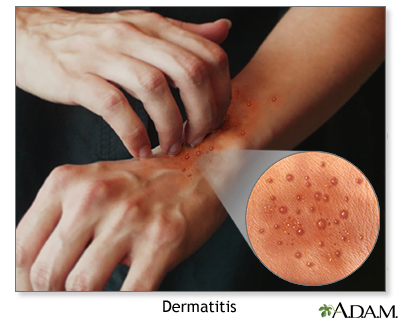| Atopic dermatitis (eczema) |
Atopic dermatitis, commonly referred to as eczema, is a chronic skin condition that usually appears in the first few years of life.
The term "atopic" refers to inherited allergic reactions. People whose parents have allergies are often born with, or develop, allergy-related antibodies (IgE) in their blood soon after birth. This makes them likely to allergies right away.
Atopic dermatitis is often related to other allergic conditions. More than 50% of people with atopic dermatitis later develop asthma and 75% develop allergic rhinitis.
Symptoms
The symptoms of atopic dermatitis are intense itching, inflammation, and sensitivity of the skin. The itchiness is usually worse at night and can disrupt sleep.
The appearance and location of the rash may depend on the age of the patient. In infants, atopic dermatitis often appears as a bubbling or oozing rash on the face, hands, and feet. In older children and adults, it may appear as a red, scaly, and itchy rash on the neck, hands, feet, and creases of the elbows and knees. During severe outbreaks, the rash may appear all over the body.
People who have atopic dermatitis can easily get skin infections because the skin is often raw and open from scratching. These secondary infections, caused by bacteria, fungi, or viruses, can make controlling dermatitis difficult.

| The symptoms of atopic dermatitis are intense itching, inflammation, and sensitivity of the skin. The reaction on the skin as seen above is one of several possible appearances of atopic dermatitis. |
Causes
The causes of atopic dermatitis are sometimes unclear. In young children, exposure to airborne allergens (e.g., pollen, dust mites, pet dander) or foods (e.g., milk, eggs, and peanuts) can cause atopic dermatitis breakouts.
Emotional stress, high temperatures, and exposure to irritants also can contribute to breakouts.
Diagnosing atopic dermatitis
If you suspect you (or your child) have atopic dermatitis, visit the doctor for a proper diagnosis. The doctor will try to determine what is causing the rash by asking about things you have been exposed to (e.g., animals, dust). The doctor may look for the characteristic scaling or bubbling, ask about the intensity of the itching, and ask about other allergies that may contribute to the dermatitis symptoms.
Allergy testing may be necessary to confirm whether the rash is caused by food or airborne allergies.
Treatment
Avoid scratching the rash if you can -- relieve the itch by using a cold compress or lubricating the skin with ointment or mild, unscented lotion.
If you have allergies, take steps to avoid the allergens that cause symptoms. If this doesn't help, over-the-counter topical corticosteroid creams may relieve itching and inflammation. Stronger prescription medicines are also available. In addition, if you get a secondary infection caused by scratching, your doctor may prescribe an antibiotic or antifungal medication.
References
Fonacier LS, Dreskin SC, Leung DY. Allergic skin diseases. J Allergy Clin Immunol. Feb 2010;125(2 supp 2):S138-49.
Hanifin JM, Cooper KD, Ho VC, Kang S, Krafchik BR, Margolis DJ, et al. Guidelines of care for atopic dermatitis. J Am Acad Dermatol. 2004 Mar;50(3):391-404.
Leung DY, Nicklas RA, Li JT, Bernstein IL, Blessing-Moore J, Boguniewicz M, et al. Disease management of atopic dermatitis: an updated practice parameter. Joint Task Force on Practice Parameters. Ann Allergy Asthma Immunol. 2004 Sep;93(3 suppl 2):S1-21.
Lewis-Jones S, Mugglestone MA; Guideline Development Group. Management of atopic eczema in children aged up to 12 years: summary of NICE guidance. BMJ. 2007;335:1263-1264.
Reviewed By: Paula J. Busse, MD, Assistant Professor of Medicine, Division of Clinical Immunology, Mount Sinai School of Medicine, New York, NY, Review provided by VeriMed Healthcare Network. Also reviewed by David Zieve, MD, MHA, Medical Director, A.D.A.M., Inc.
